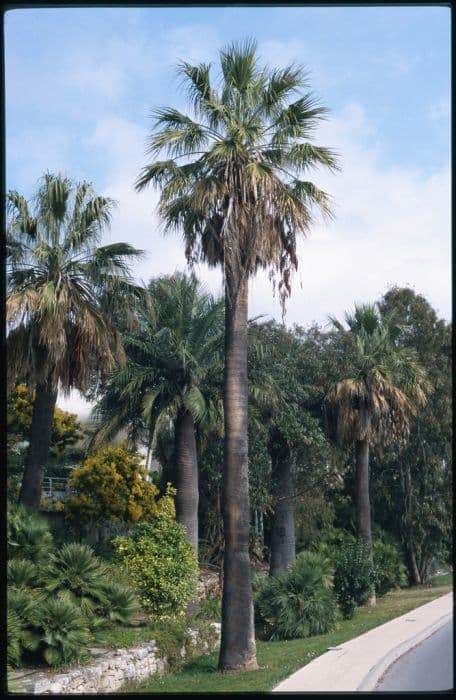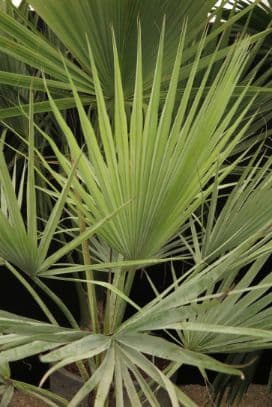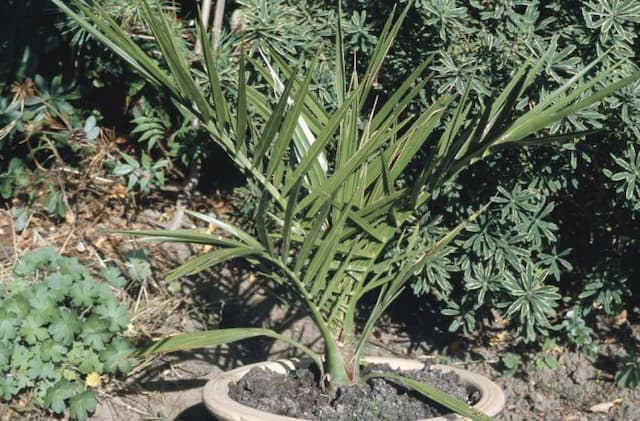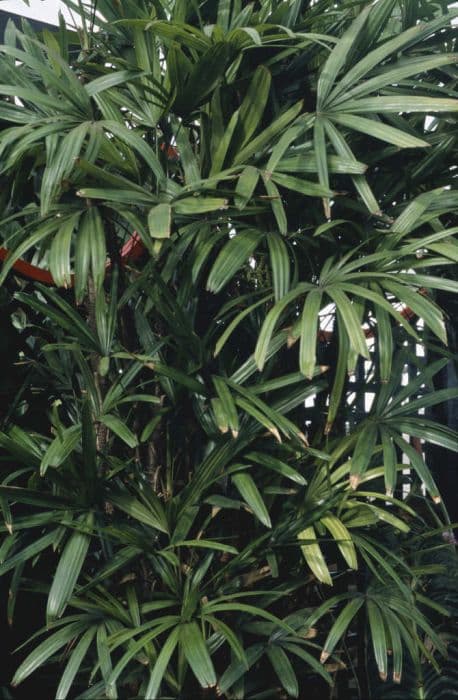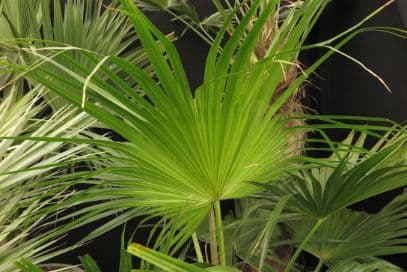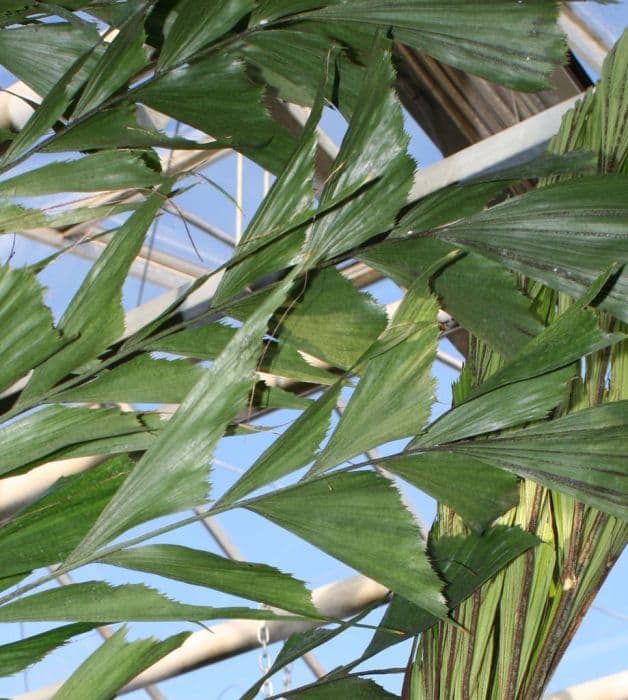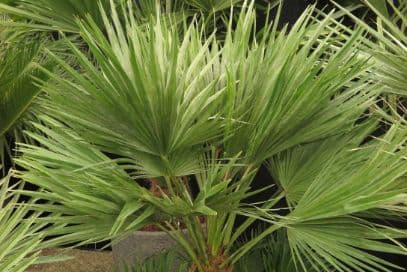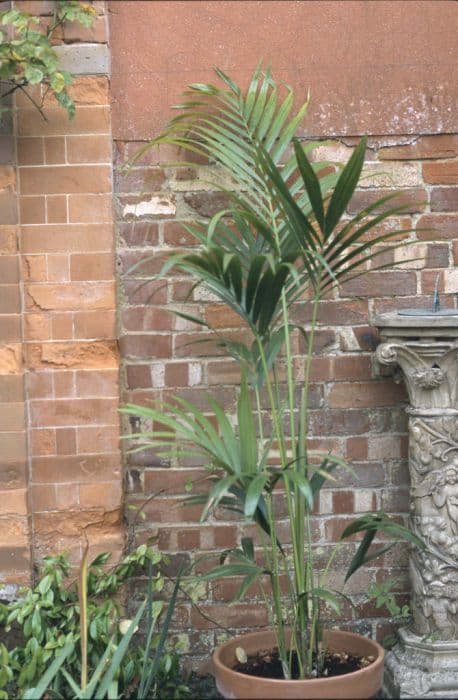Bangalow Palm Archontophoenix cunninghamiana

ABOUT
The King Palm is a stately and elegant tropical plant cherished for its graceful appearance. It possesses a slender, smooth trunk that is grayish in color, giving it a sleek look that stands out in landscaped gardens. At the crown, a burst of feathery fronds fans out, displaying a lush green color that offers a lively contrast against the muted tones of the trunk. These fronds arch slightly at the tips, adding to the plant's majestic silhouette and providing a sense of movement even on calm days. At the base of each frond, a crownshaft forms, characterized by its bright green color and slightly swollen appearance, adding a touch of distinction to the plant's profile. It's within this area that the King Palm produces its flowers. The flowers themselves are small and not particularly showy, often overshadowed by the plant's overall lush appearance. Following the flowering phase, the King Palm develops clusters of small, red to deep violet fruits, which dangle beneath the crown of fronds. These berry-like fruits are attractive to birds and other wildlife, adding an interactive element to the plant's presence in the garden. With its tropically-inspired looks and ornamental features, the King Palm is a popular choice for creating a relaxing, resort-like ambiance in landscapes that can support its growth needs. Its sleek appearance and the breezy canopy of fronds make it a visually appealing specimen, often used to line avenues or as a focal point in both public and private gardens.
About this plant
 Names
NamesFamily
Arecaceae
Synonyms
King Palm, Bangalow Palm, Piccabeen Palm, Seaforthia Palm
Common names
Archontophoenix alexandrae, Archontophoenix cunninghamii, Archontophoenix paludosa, Jessenia glazioviana, Ptychosperma alexandrae, Seaforthia elegans.
 Toxicity
ToxicityTo humans
The most common common name of Archontophoenix cunninghamiana is the King Palm. King Palm is not generally considered to be toxic to humans. There is no widespread evidence or documentation indicating that ingestion of its parts causes poisoning in humans. However, like with any plant material, individual allergies or sensitivities may exist, and ingesting plant parts is not typically advisable without certainty regarding their edibility and safety.
To pets
The King Palm is the most common common name for Archontophoenix cunninghamiana. This plant is not known to be toxic to pets. While it is not reported to cause any specific symptoms of poisoning, it is generally recommended to prevent pets from ingesting plants that are not confirmed to be safe, as they might cause gastrointestinal upset or an allergic reaction in sensitive animals.
 Characteristics
CharacteristicsLife cycle
Perennials
Foliage type
Evergreen
Color of leaves
Green
Flower color
Varies
Height
50 feet (15 meters)
Spread
15 feet (4.5 meters)
Plant type
Palm
Hardiness zones
9
Native area
Australia
Benefits
 General Benefits
General Benefits- Ornamental Value: Archontophoenix cunninghamiana, commonly known as the King Palm, has an elegant appearance that enhances the aesthetic of gardens and landscapes.
- Shade Provider: Its tall canopy offers pleasant shade, making it suitable for use in parks and large gardens.
- Wildlife Habitat: It provides a habitat for a variety of wildlife, including birds and small animals, which find shelter and food in its foliage and fruits.
- Soil Stabilization: The King Palm can help to stabilize soil, especially in sloped areas, reducing erosion and runoff.
- Urban Tolerance: It is relatively tolerant of urban pollution, which makes it a suitable choice for city environments.
- Carbon Sequestration: Like other trees, it captures carbon dioxide from the atmosphere, contributing to carbon sequestration efforts.
 Medical Properties
Medical PropertiesThis plant is not used for medical purposes.
 Air-purifying Qualities
Air-purifying QualitiesThis plant is not specifically known for air purifying qualities.
 Other Uses
Other Uses- The King Palm's fronds can be used in thatching for traditional and decorative roofing in some indigenous cultures.
- Because of its smooth and attractive trunk, the King Palm is often used in ornamental landscaping and garden designs.
- The tree's seeds may be used as beads in jewelry-making due to their hard and durable nature.
- The fibrous material from the fronds can be woven into mats, hats, or bags in some artisan crafts.
- Kids sometimes use the fallen fronds as makeshift play swords or tools for imaginative play outdoors.
- Large fronds can act as natural fans or sunshades during outdoor events or in tropical climates.
- The palm hearts or inner cores are edible and considered a delicacy in some culinary traditions.
- The trunks of King Palms can be hollowed out and used as rustic water pipes or guttering in eco-construction projects.
- Sometimes, during cultural festivals, fronds from the King Palm may be used as part of costumes or worn as ceremonial adornments.
- The bark of the King Palm has been used in the creation of small craft items, such as pots or planters, due to its unique texture.
Interesting Facts
 Feng Shui
Feng ShuiThe King Palm is not used in Feng Shui practice.
 Zodiac Sign Compitability
Zodiac Sign CompitabilityThe King Palm is not used in astrology practice.
 Plant Symbolism
Plant Symbolism- Aspiration and Success: King Palm, as it is commonly called, often symbolizes high aspirations and success due to its tall and regal stature that seems to reach for the skies.
- Royalty and Pride: The name "King" Palm implies a sense of royalty and pride, reflecting an air of magnificence and grandeur.
- Resilience and Adaptability: The King Palm's ability to grow in various soil types and withstand different environments represents resilience and adaptability.
- Tropical Beauty: This plant is native to Australia's rainforests, and its lush appearance is often associated with tropical beauty and exotic allure.
- Growth and Vitality: The King Palm's rapid growth rate signifies vitality and the persistent force of life.
 Water
WaterThe King Palm should be watered regularly to keep the soil consistently moist but not soggy. During the growing season in spring and summer, it typically requires watering once a week, but this may increase to twice a week in very hot weather. The amount of water needed at each watering session is approximately 1 to 1.5 gallons for an outdoor plant, depending on the size and the weather conditions. Reduce watering frequency during the fall and winter to every other week, allowing the top inch of soil to dry out between watering sessions. Always ensure that the plant has adequate drainage to prevent root rot.
 Light
LightThe King Palm thrives in bright, indirect light when grown indoors and partial shade to full sun outdoors. It should be protected from direct midday sun to prevent leaf burn. The best spot for a King Palm would be in an area where it can receive filtered sunlight throughout the day or direct sun during the morning hours.
 Temperature
TemperatureThe ideal temperature range for a King Palm is between 65°F and 85°F. It can tolerate a minimum temperature of around 35°F, but frost can cause damage to the foliage. It's important to ensure that the palm is not exposed to sudden temperature drops and to protect it from cold drafts.
 Pruning
PruningPrune the King Palm to remove dead or yellowing fronds, which will promote healthy growth and improve the plant's appearance. Pruning is best done in the spring or early summer when the plant is actively growing. It's typically only necessary once a year or less often, as the palm has a self-cleaning habit where old fronds naturally drop off.
 Cleaning
CleaningAs needed
 Soil
SoilThe King Palm thrives in well-draining, slightly acidic to neutral soil with a pH of 5.5 to 7.5. A good mix consists of peat, pine bark, and perlite or coarse sand, which ensures proper moisture retention and aeration. Regularly check the soil pH to maintain these ideal conditions.
 Repotting
RepottingKing Palms should be repotted every two to three years in their juvenile stage to accommodate their growing root systems. Mature palms, however, can be repotted less frequently, possibly every 3-5 years, and ultimately, they may settle well into a large pot or be planted out.
 Humidity & Misting
Humidity & MistingKing Palms prefer high humidity levels of around 60% or higher. To achieve optimal growth indoors, it's beneficial to use a humidifier or regularly mist the leaves to maintain these humidity requirements.
 Suitable locations
Suitable locationsIndoor
Place in bright, indirect light with high humidity.
Outdoor
Plant in partial shade, shelter from wind, moist soil.
Hardiness zone
9b-11 USDA
 Life cycle
Life cycleThe King Palm (Archontophoenix cunninghamiana) begins its life as a seed, typically germinating in the warm, moist conditions of its native rainforest understorey. Germination can take several months, after which a single shoot emerges, developing into a juvenile palm with a slender stem and feathery leaves. As the palm matures, it grows upright, forming a smooth, gray trunk with ringed scars from fallen leaves, and its canopy expands with pinnate leaves that can reach several meters in length. Upon reaching sexual maturity, which can occur within 5 to 7 years, it produces inflorescences of small, white to lilac flowers from among the leaves, followed by bright red or purple fruits. The fruits are often eaten by birds, which aid in seed dispersal. The King Palm can live for several decades, continuing to grow taller, with some specimens reaching up to 40 meters high.
 Propogation
PropogationPropogation time
Spring-Early Summer
The King Palm, more formally known as Archontophoenix cunninghamiana, is best propagated through the sowing of seeds. The ideal time to propagate by seed is during the warmer months when temperatures remain consistently above 75°F (24°C), as this tropical plant requires warmth for optimal germination. Fresh seeds exhibit the highest viability and should be sown directly in a moist, well-draining growing medium. After sowing, the seeds need a consistent supply of moisture and should not be allowed to dry out, but they also must not be waterlogged. It generally takes several weeks to a few months for King Palm seeds to germinate, and patience is key in this process. Once seedlings have emerged and established a few sets of true leaves, they can be carefully transplanted into individual pots to continue their growth.
